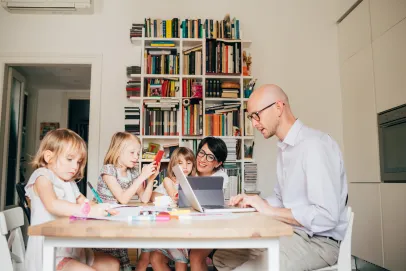Finding Balance in the Unknown
April 14, 2020
 By:
Kendall Hunt
By:
Kendall Hunt
Across the world, countries are being affected by COVID-19, and on March 11, the World Health Organization (WHO) declared the virus a pandemic. Around the globe, schools have closed for the foreseeable future as college campuses vacate and K-12 schools closed their doors.
Days off of school aren’t rare, but a complete shutdown is brand new territory that has never been experienced. The health and safety of students and faculty are at the top of the priority list as schools close for an unknown amount of time. Alongside health being the top priority, learning opportunities and emotional wellness must be addressed for the students. As parents, it is difficult to navigate having your children at home and taking over as acting as educators until schools reopen.
Continued Learning Opportunities from Home
While most colleges and universities around the world have adapted to online courses, eLearning isn’t an option for all K-12 schools. Many students don’t have access to the technology necessary to participate in eLearning, creating an obstacle to this form of education. A recent study by Schoology has shown that 50% of schools are 1-to-1, and half of those schools allow students to bring the school’s devices home. No matter how a parent decides to navigate continuing education at home, many available resources can be found, or your child’s school may provide resources to use.
Planning
It may be daunting to take over, but try to take it one day at a time, especially at first. This is a large transition for everyone involved, and taking it slow will help with the adjustment period. If your school provides resources to use, be sure to use them and monitor your child to ensure lessons are being done. Do your best to stay up to date with your school to monitor all new changes and get regular updates. If you require resources, various educational apps are available that can be downloaded. Kahoot offers apps that are great for children of any age. Check-in with places like your local library as well, they may be able to help you find resources that meet your needs. During this time of uncertainty, our team here at Kendall Hunt wants to make sure students still have the option and ability to continue learning. We invite you to browse some special offerings just for those who are looking for resources to share with students or do at home. Our digital resources include access to online curriculum, activities, and webinars.
Set a schedule
The age-old phrase is true, consistency is key. Without going to school every day now, your child’s schedule is different. Having a consistent, daily schedule will help make home learning easier and create a routine to follow. Try to set check-in times periodically throughout the day to see if they’re on track and work is being done. If you are using an electronic resource, you may be provided with checkpoints to help track progress within the resource.
Reach Out
This transition is difficult for the teachers as well as the students. Reach out to your child’s teachers and check in on how they’re doing. This can also be used as a time to ask for help on how to help your children continue learning. If it is possible, you can also give your child a chance to speak with their teacher. Whether it’s through a video app or a phone call, it’ll be a great pick me up for all involved.
Emotional Wellness
School has been a part of your child’s life for the past eight months and many of their classmates were their friends as well. For children, simply not being in their normal routine, seeing classmates and friends, adds to their stress. The older your children are, the stronger their emotions might be. It is important that during this time, you check in with your child to see how they are doing. Be available for your child to talk to you, and admit your own emotions as well without instilling fear. Feeling that they’re not alone will validate their emotions and be beneficial to both of you.
At the end of the day, it may be difficult to remember what we’re doing this for. But as parents, we are here for our children.
“We must continue to be there for our students in the face of extended closures. We must show students the definition of perseverance—that even in the face of unprecedented adversity, we continue forward,” said Joseph and Ravesi-Weinstein.
COVID-19 has changed the world and our lives, but one thing will remain true, we will get through this with each other.
